When it gets cold and snowy, birds have a big problem: finding enough food. Studies show small birds can lose up to 10% of their weight on a cold night. This shows how important a good winter diet is for them.
This guide will cover what birds need to eat in winter. We’ll look at both natural and extra food sources. We’ll also talk about how to keep feeders clean and well-stocked. These tips can really help your backyard birds make it through the cold months.
Key Takeaways
- Birds face unique challenges during winter, including increased energy needs and scarce natural food sources.
- A well-balanced winter bird diet should include a variety of high-energy foods, such as sunflower seeds, suet, and protein-rich options.
- Proper feeder maintenance and placement are crucial to ensure birds have access to clean, unfrozen food and water.
- Offering a diverse array of feeding options can attract a wider range of bird species to your backyard.
- Understanding the specific dietary needs of different bird species can help you tailor your feeding station to their preferences.
Understanding Winter Bird Survival Challenges
When it gets colder and the days get shorter, birds face big challenges. They must keep their body temperature at about 105°F. They also need to find enough food to keep their metabolism going.
Temperature Regulation and Energy Needs
It might seem smart for birds to move to warmer places in winter. But many can’t and stay in the cold. Chickadees, for example, fluff out their feathers to stay warm. They also find cozy spots to sleep, where their feet can get close to freezing.
These tricks help them save energy and keep their body warm.
Natural Food Source Scarcity
Winter makes it hard for birds to find food. There’s less greenery and fewer insects. Chickadees and Golden-crowned Kinglets have to work together to find enough to eat. They learn from each other to get more food.
Woodpeckers use their special bills to find insects in trees. This helps them get through the winter.
Adaptation to Cold Weather
Birds have many ways to deal with winter. Ruffed Grouse eat tree buds to get the nutrients they need. Golden-crowned Kinglets huddle together at night. This helps them stay warm and safe.
Winter is tough for many birds, but their clever ways to survive are amazing. By learning about these strategies, we can help them make it through the coldest months.
Essential Winter Bird Diet Components
When it gets cold, birds need food that’s full of energy. They look for black-oil sunflower seeds, suet, peanuts, and safflower seeds. These foods give them the fats and proteins they need to stay warm.
Having different foods in your bird feeders can attract many birds. For instance, tube feeders attract small birds like chickadees. Hopper feeders draw in bigger birds like cardinals. Suet feeders are a hit with woodpeckers, and thistle feeders are loved by goldfinches.
Ground feeders with cracked corn, millet, sunflower seeds, and grains help birds like doves. By offering a variety of high-energy bird feed, you help many birds through the winter.

“Over a hundred bird species rely heavily on feeders during winter when natural food sources are scarce.”
What Do Birds Eat in the Winter?
When it gets cold, birds need to find new food to stay warm. They look for foods that give them lots of energy. This helps them keep warm and get ready for spring.
Natural Food Sources
Birds eat berries from holly and juniper trees. They also eat seeds from plants that didn’t die off. They find insects in tree bark too. These foods give them the energy they need.
Supplementary Feeding Options
Many people help birds by putting out special food. They use black oil sunflower seeds, suet, peanuts, and seed mixes. These foods give birds the extra energy they need.
Dietary Changes from Summer to Winter
In summer, birds eat insects and nectar. But when it gets cold, they switch to seeds and berries. These foods give them the energy to stay warm and get ready for spring.
By offering both natural and special foods, we help birds get through the winter. This way, they can make it to spring in good shape.
| Natural Food Sources | Supplementary Feeding Options |
|---|---|
|
|
Black Oil Sunflower Seeds: The Ultimate Winter Bird Food
When it gets cold, birds in your yard need food that’s full of energy and nutrients. Black oil sunflower seeds are a top choice for many birds. They love these seeds because they’re packed with calories and nutrients.
These seeds are small and have a thin shell. This makes it easy for birds to get to the good stuff inside. Birds like cardinals, chickadees, and finches all enjoy these seeds. They help keep the birds warm and full of energy.
Black oil sunflower seeds are better for birds with small beaks. They can easily crack open the seeds. This saves them energy and lets them get to the food inside.
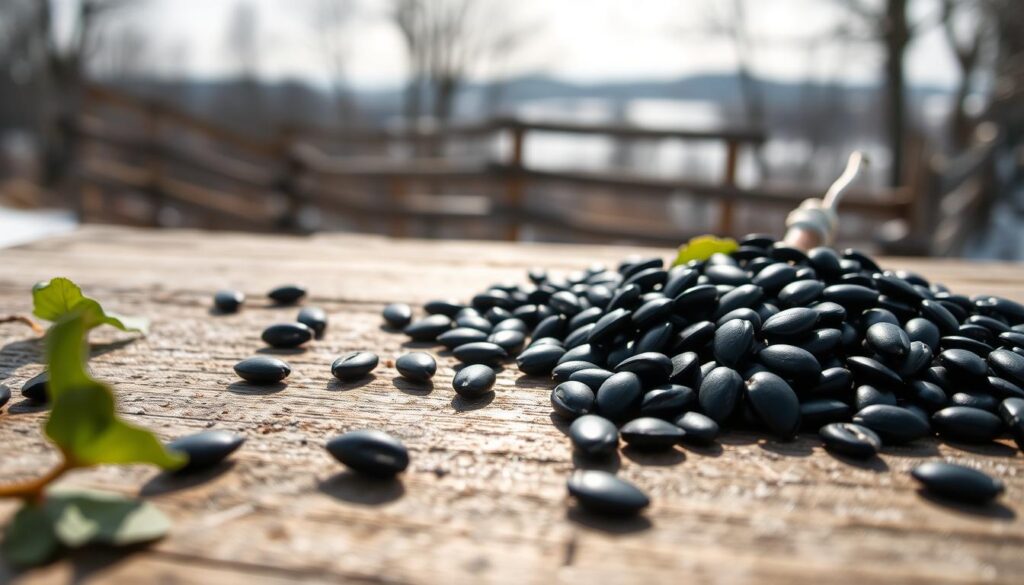
These seeds are also great for people who like to feed birds. They’re easy to find, not too expensive, and can be bought in big batches. By offering black oil sunflower seeds, you can attract many different birds to your yard. This helps them stay healthy and happy during the winter.
High-Energy Foods for Winter Bird Survival
When it gets cold and food is hard to find, birds need our help. Suet cakes, protein-rich foods, and calorie-dense seeds are great for keeping them warm and fed.
Suet and Fat-Based Foods
Suet cakes are a favorite for birds in winter. They’re full of fat, which gives birds the energy and nutrients they need. You can buy suet cakes or make your own, adding things like berries or sunflower seeds for extra nutrition.
Protein-Rich Options
Mealworms and peanut butter are also good for birds in winter. They help birds keep their muscles strong, which is important for staying warm. Offering different protein sources can attract more bird species to your yard.
Calorie-Dense Seeds
Seeds like sunflower hearts and safflower are full of calories. They give birds the energy they need to stay warm. Having a variety of these seeds ensures your backyard birds get the nutrition they need all winter.
By offering suet cakes, protein-rich foods, and calorie-dense seeds, you can help birds survive the winter. These foods provide the essential nutrients and calories they need to stay healthy during the coldest months.
The Role of Suet in Winter Bird Feeding
When it gets cold and food is hard to find, suet is a key part of a bird’s diet. It’s full of fat, giving birds the energy they need to stay warm. This is especially true during the winter.
Many birds, like woodpeckers and chickadees, love suet. It’s packed with calories, helping them get through the cold months. This food is a big help for birds trying to stay warm.
Having a good suet bird feeder is important. Metal ones last longer and can handle the weather better. Putting up several feeders can bring more birds to your yard.
Making your own suet with peanut butter or nut butter can save money. Buying it in bulk is also smart, keeping you stocked for months. But, make sure to change out old suet to keep birds coming back.
It’s also key to keep squirrels out of your suet feeders. They can eat all the food meant for birds. By protecting your feeders, you make your yard a cozy spot for birds to find food.
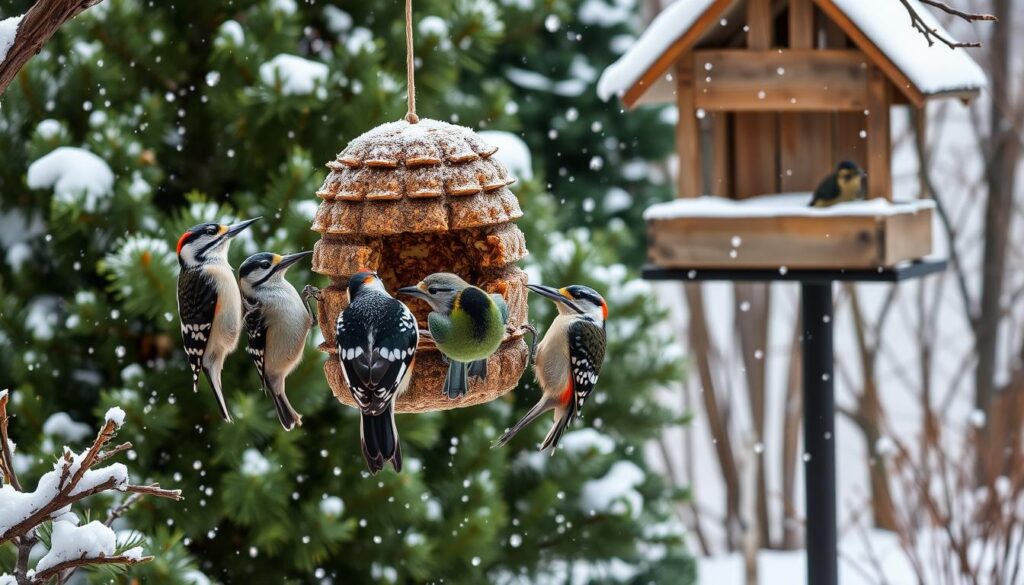
Suet is a vital source of energy for birds in the winter. When spring comes and food is easier to find, fewer birds will visit your feeders.
| Feature | Benefit |
|---|---|
| Cost-effective suet feeding | Refill suet cakes can be purchased for less than a dollar, making it an affordable way to support winter birds. |
| Variety of birds attracted | Suet feeders attract a diverse range of birds, including woodpeckers, chickadees, nuthatches, blue jays, titmice, wrens, and cardinals. |
| Positioning suet feeders | Hang suet feeders at a vantage point visible from inside your home, within ten feet of protective cover to encourage bird visitation. |
Natural Fruits and Berries for Winter Birds
When winter comes, many birds look for food in the form of fruits and berries. These foods are full of nutrients and add variety to their diet.
Fresh Fruit Options
Cut-up apples, grapes, and oranges can draw many fruit-eating birds to your yard. These fruits give birds the vitamins, minerals, and calories they need to stay warm and active.
Dried Fruit Alternatives
For a longer-lasting snack, try dried fruits like raisins and cranberries. Just soak them in warm water first. This makes them a great, easy-to-store option for winter berries for birds.
Adding these fruits and berries to your winter bird feeding can attract many birds. It also helps them get the nutrients they need to stay healthy during the coldest time of the year.
| Fresh Fruit Options | Dried Fruit Alternatives |
|---|---|
| Apples | Raisins |
| Grapes | Cranberries |
| Oranges | – |
“Offering a variety of natural fruits and berries in your winter bird feeding station can help attract a diverse range of fruit-eating birds and provide them with the essential nutrients they need to survive the cold months.”
Peanuts and Tree Nuts as Winter Bird Food
When winter comes, birds struggle to find food. Peanuts and tree nuts are great because they have lots of protein and energy. They help birds stay warm and strong during the cold months.
Peanuts are loved by many birds like woodpeckers and jays. They prefer unsalted, dry-roasted peanuts without shells. This makes it easy for them to eat and get the most nutrition.
Tree nuts like almonds and walnuts are also a hit with winter birds. They are full of calories and nutrients. This helps birds when their usual food is hard to find.
- Peanuts and tree nuts are excellent high-protein, high-energy foods for winter bird feeding.
- They attract a wide variety of nut-eating birds, including woodpeckers, jays, nuthatches, and titmice.
- Offer unsalted, dry-roasted peanuts without shells for easy consumption and maximum nutritional benefit.
- Nuts provide essential fats and proteins, helping birds maintain energy levels during cold weather.
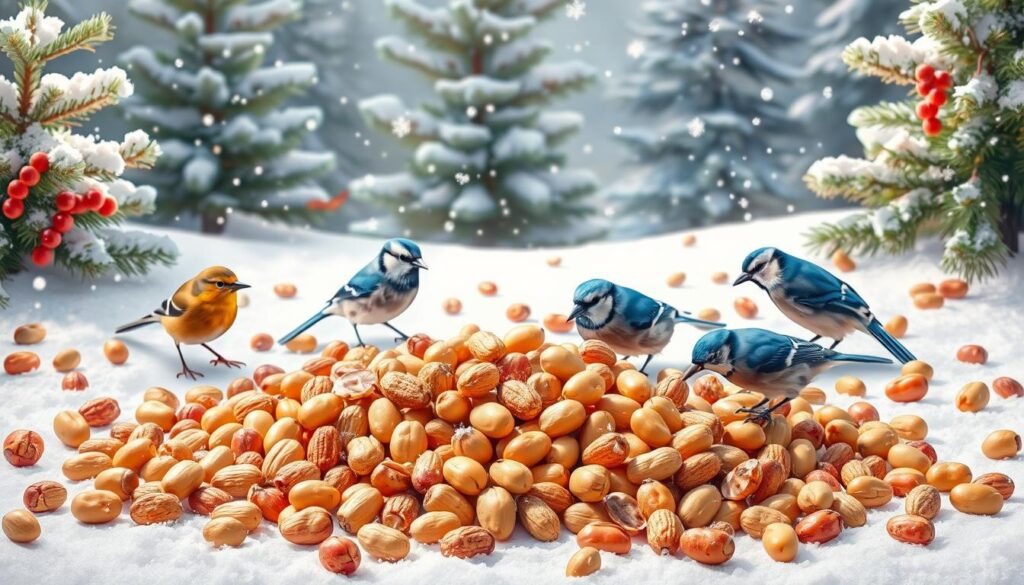
“Peanuts and tree nuts are a lifeline for birds during the harsh winter months, providing the nourishment they need to survive and thrive.”
Adding peanuts and tree nuts to your bird feeding can really help. It gives birds the energy they need to stay healthy and happy all winter.
Proper Winter Bird Feeder Maintenance
Keeping bird feeders clean during winter is key for our bird friends’ health. Clean feeders keep food fresh and stop disease spread among birds.
Cleaning and Sanitization
Clean bird feeders every two weeks, even in winter. Use warm, soapy water to scrub them. Remove grime and rinse well. Let the feeder dry before adding fresh bird seed.
This simple step keeps a safe space for winter bird care.
Snow and Ice Management
Snow and ice can block bird feeders. After a storm, brush off snow and ice. This lets birds access food.
Adding drainage holes helps prevent moisture buildup. This stops seed spoilage and bird harm.
Spending a bit of time on bird feeder maintenance helps birds through winter. Good care supports local birds during tough times.
Strategic Feeder Placement for Winter
Putting bird feeders in the right spot is key in winter. Birds have a hard time finding food outside. By placing your feeders wisely, you help them stay safe and fed.
Place your feeders near evergreen trees or thick shrubs. These spots protect birds from wind and predators. Make sure your feeders are at different heights to meet the needs of various bird species.
- Situate feeders within 12 feet of cover, such as shrubs or trees, to help birds feel secure while feeding.
- Position feeders at least 30 feet away from windows to prevent deadly collisions.
- Avoid placing feeders in direct line with reflective surfaces, as this can also lead to bird collisions.
Think about how close your feeders are to your house. Having them near windows makes it easy to watch and refill them. But, remember to prevent birds from hitting the windows by using decals or netting.
| Feeder Placement Considerations | Ideal Recommendations |
|---|---|
| Distance from cover | Within 12 feet of shrubs or trees |
| Distance from windows | More than 30 feet away or closer than 3 feet |
| Feeder height | Varying heights to accommodate different species |
| Proximity to home | Near windows for easy viewing and maintenance |
By carefully placing your bird feeders and winter feeding station, you make a welcoming spot for birds. This ensures they get the food they need to stay healthy and strong during the cold months.
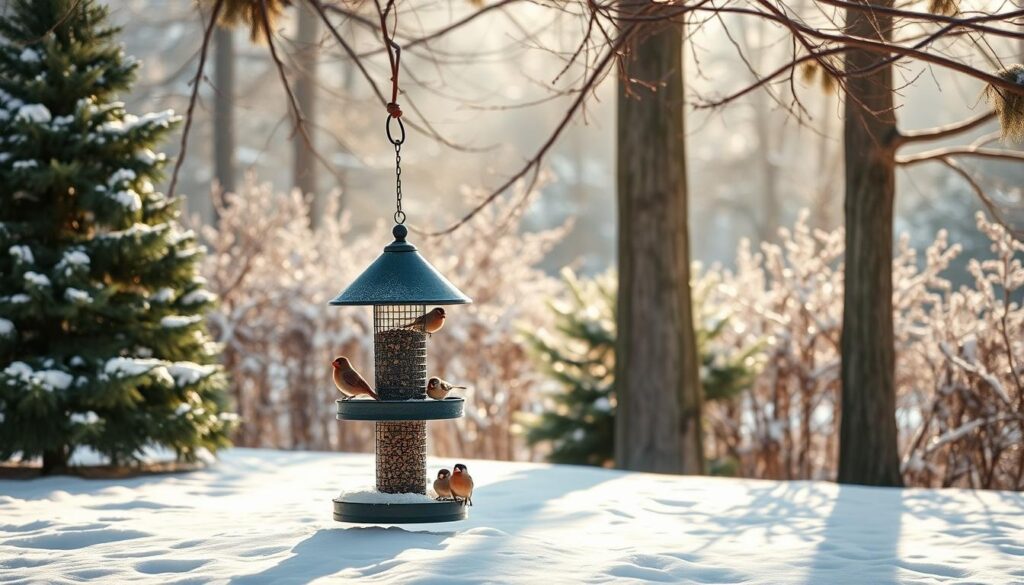
Creating a Winter Bird Feeding Station
When it gets cold and food is hard to find, a winter bird feeding station is a big help. It’s key to have different types of feeders and food in the right spots. This attracts many kinds of birds.
Different Feeder Types
Having a variety of feeders is crucial for a good winter feeding station. You should have different types to meet the needs of different birds:
- Platform feeders for ground-feeding birds like doves, sparrows, and juncos
- Tube feeders for small perching birds such as finches, chickadees, and nuthatches
- Suet cages for woodpeckers, flickers, and insect-eating birds
Food Variety and Placement
Choosing the right food and where to put it is also important. Offer a variety of high-energy foods, including:
- Black oil sunflower seeds, preferred by finches, chickadees, and grosbeaks
- Millet for ground-feeding birds like doves and sparrows
- Striped sunflower seeds and peanuts for jays and woodpeckers
- Nyjer® seed, or thistle, favored by goldfinches and Pine Siskins
- Suet cakes or tubs for insect-eating birds like woodpeckers and chickadees
Put feeders at different heights and places. Also, make sure to have fresh, unfrozen water. This will help meet the needs of all the birds in your area.
Providing Fresh Water During Winter
When it gets cold and water sources freeze, birds face a big challenge. They need water to stay warm and hydrated. Without it, their survival is at risk.
A heated bird bath is a great solution. It keeps water from freezing, even in the coldest weather. Placing one near your bird feeders will attract many birds.
You can also add a heated bird water element to your existing bird bath. These devices are easy to install and keep water from freezing. They’re a budget-friendly way to help your backyard birds.
- Regularly clean and refill the bird bath to ensure the water remains fresh and free of contaminants.
- Position the bird bath in a sunny spot to help delay the onset of freezing temperatures.
- Incorporate perches and rough surfaces to allow birds to easily access the water and avoid slipping.
- Avoid adding any chemicals, such as glycerin, to the water, as these can be harmful to birds.
Providing fresh water in winter can greatly help local birds. It’s a simple act that can attract many species. It also boosts the health of birds in your area.
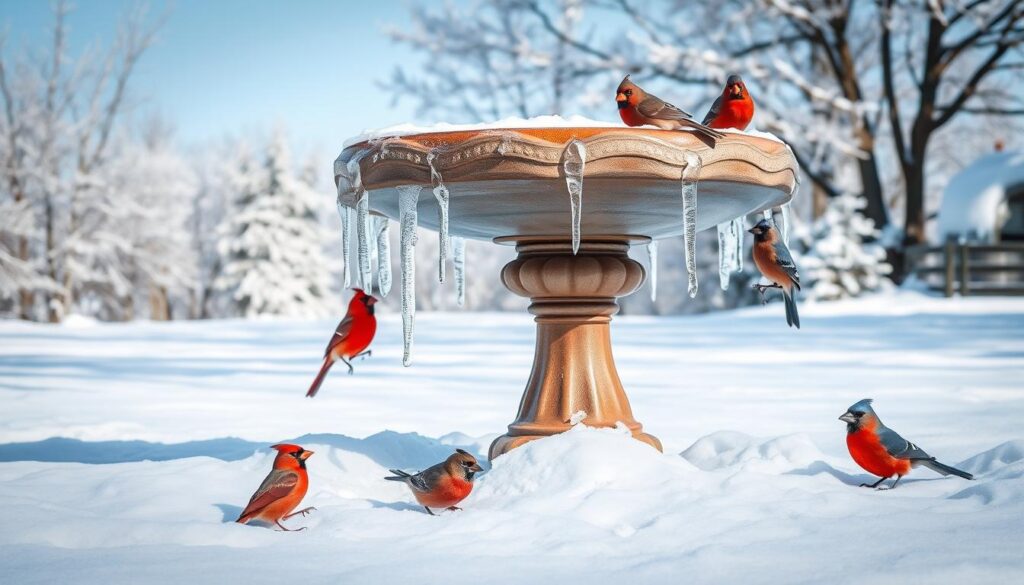
Common Winter Feeding Mistakes to Avoid
As winter comes, bird lovers need to watch out for mistakes that can hurt birds. Staying away from these errors helps keep birds healthy and happy in our backyards.
Steer clear of human food leftovers or salted seeds. These can harm birds’ sensitive stomachs and should not be given. Also, wet and moldy seed can make birds sick. So, use feeders that drain well to keep the seed dry.
Don’t stop feeding birds suddenly. Birds might depend on your feeders, and stopping can hurt them. Keep feeding regularly to help your bird friends.
Cleaning and sanitizing feeders is key to stop diseases in birds. Neglecting this can be very bad. Bacteria, mold, and parasites can grow in dirty feeders.
By avoiding these bird feeding errors and following winter bird care tips, you can help birds survive the cold months.
Special Winter Dietary Needs of Different Bird Species
When it gets cold and food is hard to find, birds must change how they eat to stay alive. Knowing what each bird species needs can help them get the right food during winter.
Ground Feeding Birds
Ground-feeding birds like juncos and sparrows look for seeds on the ground or in low feeders. They eat grains, seeds, and insects. Giving them black-oil sunflower seeds, millet, and cracked corn on the ground or in low feeders meets their needs.
Perching Birds
Perching birds, such as chickadees, finches, and titmice, like feeders with small perches. They can easily get seeds and suet from high places. Offering black-oil sunflower seeds, nyjer seeds, and suet attracts many perching birds to your feeder.
FAQ
What are the key challenges birds face in the winter?
Birds have to deal with more energy needs and less food in winter. They must keep warm and find enough to eat to make it through the cold.
What types of high-calorie, high-fat foods are essential for birds in the winter?
Important foods for winter birds include black-oil sunflower seeds, suet, peanuts, and safflower seeds. These give birds the fats and proteins they need to stay warm and energized.
How do birds’ diets change from summer to winter?
In winter, birds eat more high-calorie foods. They look for berries, seeds, and insects, and also get help from humans with seeds, suet, and fruits.
Why are black-oil sunflower seeds considered the best all-around bird seed for winter feeding?
Black-oil sunflower seeds are full of fat, easy to crack, and attract many birds. They’re key for feeding birds in the winter.
How can suet help birds survive the winter?
Suet is a high-fat food that gives birds quick energy. It’s especially good for woodpeckers, nuthatches, and chickadees, helping them stay warm at night.
What types of fruits and berries are important winter food sources for birds?
Fresh fruits like apples, grapes, and oranges are great. Dried fruits like raisins and cranberries are also good. They offer important nutrients and attract birds like robins and waxwings.
Why is proper feeder maintenance crucial in the winter?
Cleaning feeders every two weeks and removing snow and ice is key. It stops disease and keeps birds eating during bad weather.
How should winter bird feeders be strategically placed?
Put feeders near evergreen trees or shrubs for protection. Place them at different heights to meet different birds’ needs.
What are some common winter feeding mistakes to avoid?
Don’t use human food or salted seeds, as they harm birds. Keep seeds dry and don’t stop feeding suddenly, as birds may rely on your feeders.
How do the dietary needs of different bird species vary in the winter?
Ground-feeding birds like juncos and sparrows prefer seeds on the ground. Perching birds like chickadees and finches like hanging feeders. Woodpeckers and nuthatches enjoy suet feeders on trees.
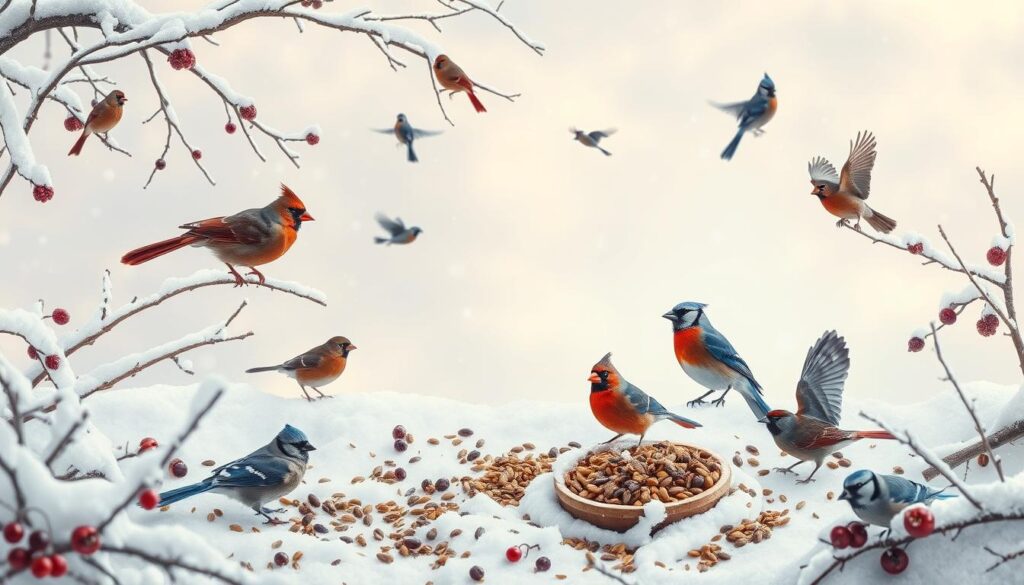

This article is a fantastic addition to the discussion—thank you!
I am extremely impressed with your writing skills and also with the structure on your weblog.
Is this a paid topic or did you modify it your self?
Anyway keep up the excellent high quality writing, it’s rare to peer
a nice blog like this one these days. Snipfeed!